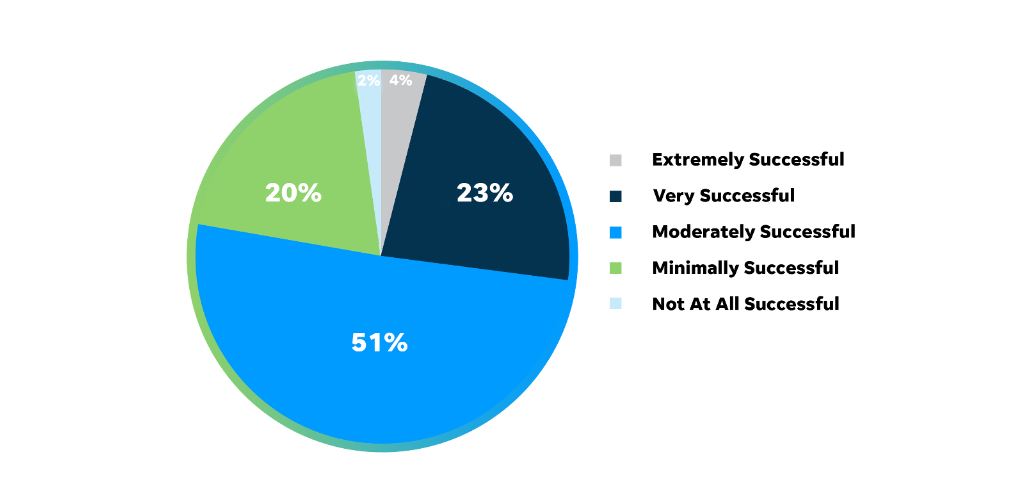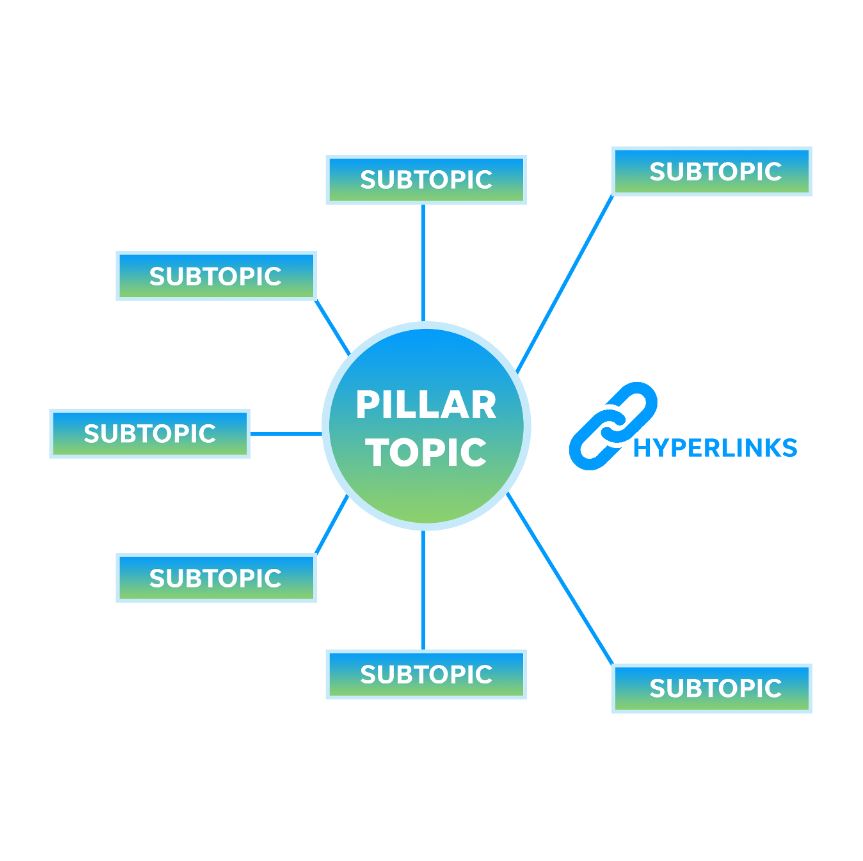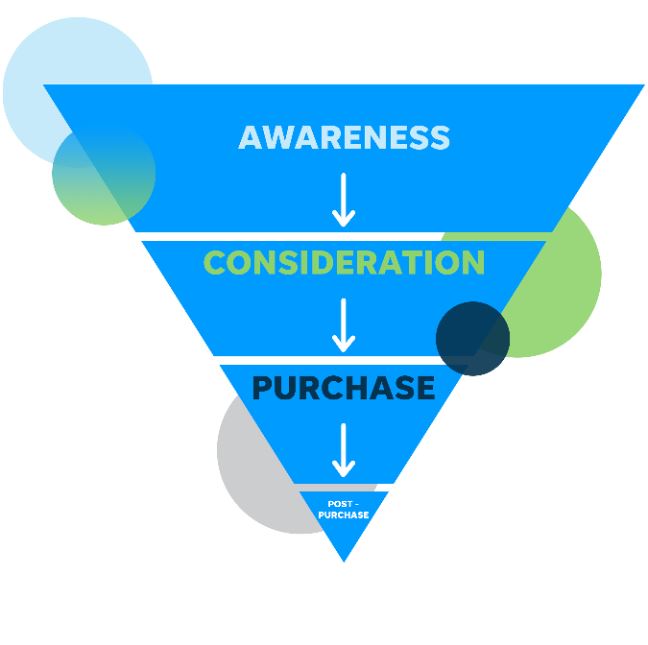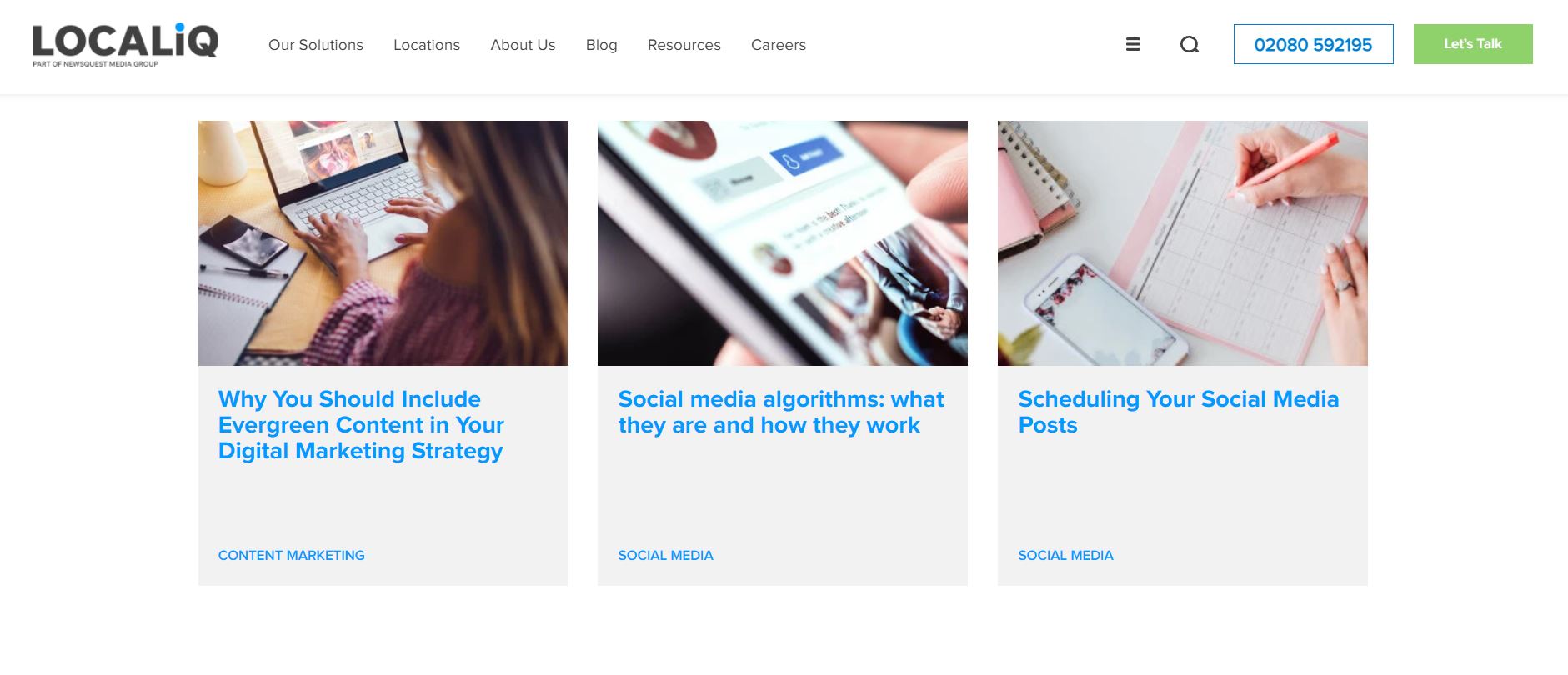The new buzzword seems to be pillar content strategy, but what does it mean and how do we create one? In short, it will help search engine algorithms find your content so that you can have a better chance of ranking on the first page.
It is no secret that writing blog posts or articles for your business website is a great way to increase the amount of content on your website, however, many marketers make the mistake of focusing on quantity over quality and pumping out short content pieces every day in the hopes of it bringing in more traffic.
According to the Content Marketing Institute, blog posts and articles are the most effective content types for demand generation in the awareness stage of the buyer’s journey, or the top of the sales funnel, according to 73% of B2B marketers. Despite this, only 27% of respondents consider their company’s content marketing initiatives to be extremely or very successful. Where’s the disconnect?
How B2B Marketers Rate Their Organisation’s Overall Level of Content Marketing Success

Image Source| LOCALiQ Branding.
The truth is that producing a large amount of high-quality content is difficult. There is a considerable difference between a business blog that is full of dull, uninformative pieces and one that is jam-packed with the kind of high-value content that naturally attracts visitors. You should take the time to build the core material that establishes your blog’s reputation as a go-to source for quality content within your industry.
What is pillar content or a pillar page?
First of all, let’s look at what pillar content is. Pillar content is content that provides a complete answer to any questions a user may be searching for on a given topic. It is specifically designed to provide value for the reader and also to rank highly in search engines. A pillar page in blogging is the main framework of a topic, similar to how you might visualise a pillar supporting a structure.
This body of content on a specific topic is more extensive than a typical blog post (usually upwards of 4,000 words). A pillar page is built around a high-volume keyword and is intended to address a wide range of questions about a specific topic. You can then develop topic clusters that branch off from the pillar page and go into significantly greater detail regarding the answers to each question. For example, you could develop a pillar content page on search engine optimisation and then create a topic cluster on the importance of SEO for your business in further depth.
Theoretically, the framework should resemble something like this.
 Image Source| An example of a Pillar Content Strategy diagram by LOCALiQ.
Image Source| An example of a Pillar Content Strategy diagram by LOCALiQ.
The following are the basic qualities of pillar content:
- It provides thorough, reliable information to solve a problem or answer a question.
- It differs from other content on the subject in terms of scope and detail.
- It is a mix of dependable, useful, and interesting.
Pillar content, in the context of business blogging, consists of your best posts. These are the posts that you would recommend to new visitors, as well as the ones that will be beneficial to readers long after they have been published.
In addition to blog posts and articles, infographics, videos, and other informative pages can also be included as pillar content., to support the chosen topic. This core material is beneficial to anyone in your field and, if done well, may be relevant to your target audience for the foreseeable future, never losing relevance and always attaining a high ranking.
Types of pillar content
There are 2 kinds of pillar content:
- Resource pillar page.
- 10x content pillar page.
The resource pillar page includes numerous amount of internal and external links. Now I know what you are thinking: “External? That is the exact opposite of what I am aiming for!” As for external linking, search engines still value it because it improves SEO and signals Google that this is an authoritative page that can successfully answer users’ questions.
A 10x content pillar page is a single page dedicated to offering the most comprehensive and well-written content on a specific topic. 10x implies 10 times better than anyone else who has written about this subject. You should be focused on all of the questions that your audience have and cover areas that they are unfamiliar with. Anchor links and subcategories are used in a 10x pillar strategy to provide optimal user experience (UX) across all devices. So now you know what a Pillar content page is, let’s look at topic clusters.
What are topic clusters?
A topic cluster objective is to strengthen your pillar page (which is the most important aspect of your pillar content strategy!) Topic clusters are specific and in-depth blog posts that link back to the core pillar page internally. Specific long-tailed keywords relevant to the in-depth topic and associated subtopics must be addressed by the topic clusters.
These pages provide thorough coverage of a certain topic as a whole. This gives a fantastic user experience for your readers because they may move from post to post to learn more about a topic. The buyer’s journey must also be considered by the topic cluster. You are not just creating content for the sake of it.

Image Source| A simplified model of the buyer’s journey by LOCALiQ.
Each part of the buyer’s journey should be represented by content in a topic cluster. You want to create a content-driven customer experience that delivers answers to queries, and relevant information, and promotes your products and services as a solution. Focusing too much on one stage of the funnel is one of the most common mistakes people make with their content. It is usually at the very bottom of the funnel. “We want people to come to our website and make a purchase.” They claim. “It is a business, not a library.” That is only one example.
There is one more that is equally as harmful. To generate traffic, some marketers focus on top-of-funnel issues at the expense of lower-volume ones. “We do not write content for low-volume keywords,” they say. Both strategies depart from the topic cluster model. Create a complete customer journey by covering the entire funnel with content. Because the buyer’s journey is not linear, you will want to cover as much territory as possible within a topic to guarantee that you have content for them, no matter where they are in their decision-making process.
Not everyone who reads your content is going to be a customer and that is ok. You want to help people who are looking for information as well as those who are ready to buy. In reality, ranking for purchase intent keywords is nearly impossible unless you have authority on the topics that surround your product pages.
Why should you consider topic clusters?
Since the launch of Google Hummingbird, the landscape of content marketing has shifted dramatically. The emphasis on keywords and pages has slightly vanished and pillar pages, content clusters, and subtopics are now in their place. All of this adds up to websites with a lot of topical authority. It’s the type that Google prefers.
Inbound marketing was pretty simple before Hummingbird. Finding popular keywords was the normal content strategy. Then you would write blog posts that corresponded to each of those keyword phrases. Each page was created with the goal of ranking for a given keyword. Because the intense focus on the page level meant little attention was paid to the site as a whole. Eventually, large sites accumulated a significant number of pages with similar content.
They could not keep track of all the keywords they were targeting! The unique content tended to be shallow. They lacked the depth required to satisfy search intent for any given subject. The ability of search engines to determine expertise is improving. As a result, smart content strategies are diverting their attention away from keywords and towards topic clusters. Topic clusters are being used to arrange their information and establish authority.
To be honest, topic clusters are not a brand-new concept. In fact, WordPress users are already familiar with a related concept known as a category. Topic clusters and categories are relatively similar. While every topic cluster is a category, not every category is necessarily a cluster. For example, on an appliance website, we might create a category for kitchen appliances, while keeping blenders and food processors in clusters.
When it comes to using topic clusters to organise a website, there are no hard and fast rules. A group should typically have at least four pieces of content, however, this is just a suggestion. In a topic cluster, your content plan may ask for many pieces of content. However, according to your schedule, you can post them one at a time. Topic clusters can also be used on existing websites. You will need to do a content audit before you can restructure an existing site. Make a list of all of your blog posts and categorise them into topics and subtopics. Eventually, you will end up with clusters of content that you will link together at a later stage.
The SEO impact of topic clustering
Topic clusters, when properly implemented, can have a major impact on SEO results in two ways. First, there is an increase in site authority and overall page ranking that is conferred to sites that comprehensively cover their chosen topic(s). Although we are only guessing, it does make sense. The stated purpose of Google is to provide relevant results that match search intent – making use of topic clusters to thoroughly cover a subject increases your chances of achieving a high ranking in your favour. But it’s not just guessing.
Internal linking, at the very least, helps distribute page rank, hence increasing the SERP performance of pages that might otherwise not do as well. As a result, attempts to improve on-page SEO are becoming increasingly vital. That is great news for you and your audience! In fact, increasing user experience is widely acknowledged as an important SEO strategy. Overall, topic clusters are useful regardless of the size of your website. Start using topic clusters today if you want your website to grow. Keep in mind that as the amount of onsite content grows, so does the influence of the content organisation. In theory, more content means greater possible coverage of a topic. This presupposes that each post is, in fact, in-depth content.
Getting started with topic clusters
When used effectively, topic clusters can be extremely effective. Start small and concentrate on providing high-quality content. Organise your current content and look for potential pillar pages. Improve those as needed and link them all together. Then, as part of your regular publishing operations, create topic clusters. Soon, you’ll have a content centre with high-quality, organised content that is easy to access for both users and search engines.
What are the benefits of using pillar content and pillar pages?
Users benefit from pillar pages because they provide all of the information, they need on a topic in one place. There are, however, other benefits for website owners, such as:
- More time spent on your website’s pages: The more content available for users to consume, the more time they’ll spend doing so.
- A lower bounce rate: If consumers find what they are looking for on your website, they are less likely to go back to Google to look for something else.
- Backlinks and a ton of social media shares: Pillar pages are widely and frequently shared, especially among influencers in a certain field.
- Gets traffic throughout the lifetime of your blog or website: Because pillar content is evergreen content, its value does not diminish over time.
- A high Google ranking: The large word count, shares, and backlinks will all help to boost your SERP visibility.
The development of pillar content requires some additional effort since it goes beyond standard blog posts. Take a look at the 5-step procedure for developing your own series of pillar blogs if you are interested in using this powerful business tool on your own website.
Step 1: Understand your audience
Building pillar content for your personal or business blog may appear to be an individual pursuit – after all, isn’t this an opportunity to share your deepest feelings and most valuable advice with your readers? Well, yes and no. It is crucial to create unique pillar content, but it is even more important that the topics you select to address resonate with your target audience. If you are counting on these critical blogs to represent your business in the best light possible, it is critical that they are useful to your readers. To do so, you must first figure out who your target audience is. In order to answer the following questions, take a close look at your social media analytics tools like your Google Analytics, and CRM database.
- Is the majority of my audience male or female?
- What is the average age of the people in my audience?
- Which ethnic groups do my audience groups belong to?
- Where are my audience members located geographically?
- What do I know about the average educational level of my audience?
- What is the average socioeconomic status of my audience members?
Answering these questions will give you some idea about how to best approach your audience within your pillar content posts, but you’ll need to conduct an even more detailed analysis on the following subject before you start writing.
Step 2: Identify your reader’s most pressing needs
Now that you know who your target audience is, it is time to find out what is on their minds, as understanding their pressing needs will help you to develop relevant topics for each of your pillar posts. There are several methods to determine the best content ideas based on your audience:
- Are you a part of your target audience? If so, try and think back to how you felt and what you were thinking about when you were a beginner in your industry. Think about the questions you had and the things you were most desperate to learn and then use these ideas as the basis for your pillar blogs.
- What is your audience talking about on social media? If you aren’t a member of your target audience, you can still gain insight into their thoughts and interests by monitoring ongoing conversations on social media platforms, especially Twitter (try using Twitter’s Advanced Search). Examine your followers’ posts to see what themes are being discussed, which blogs are shared most frequently, and which messages are being shared the most. This data should give you a starting point for producing your pillar blogs.
- What kinds of pillar content do other bloggers in your industry have? If you are still having trouble coming up with topic ideas, take a look at the most popular content pieces from your competitors. Tools like SEMrush and Ahrefs can be used to perform a competitive analysis. As long as your audiences are similar, the topics that are popular on other websites in your industry will most certainly resonate with your own just remember not to plagiarise!).
- What kind of presentation would be ideal for your target audience? How-to guides, list-based posts, statistic-based posts, quick reference guides, and roundup posts are all an example of pillar content that has the potential to be high-ranking and convey information.
- What are the barriers to success for your users? The success gap is the difference between the company’s desired outcome and the user’s desired result. For example, if you have a productivity app, your desired goal is for users to download and use it. The customers’ desired outcome is to become more productive. Your app alone won’t make them productive – they may have bad work habits, time management, or be prone to procrastination. Filling in such gaps with content can help your existing customers succeed while also attracting new people who face similar problems and are more likely to want to use your app. Give the exact topics, you’ll cover some serious thought before going on to the next phase because you will be devoting substantial resources to building your pillar content.
Step 3: Create damn good content
At this stage, you should have a few ideas for pillar content pieces that will suit your users’ needs, not only now, but in the future. It is now time to begin writing your pillar blogs! Remember that your pillar content blogs should be so helpful and engaging that audience members feel motivated to bookmark your page and share them with their friends, family, and colleagues as you go through the content creation process.
- Headline – It’s been said a million times before but keep in mind that 80% of people will read a headline and just 20% will click through to read the rest of the blog post. Make it eye-catching, intriguing, and informative because this is the first thing people will see.
- Hook – Here’s some more good news. Only 18% of individuals who click on your article will read it all the way through. Your lede (or hook), the first sentence of your blog post, must entice the reader to continue reading. Here are a few ideas for your hooks:
- Interesting facts that they have not heard before.
- An anecdote, a cliffhanger, or the end of a story.
- A direct question that the reader resonates with.
- A reference to current events.
- Story – People enjoy stories because it creates a human connection based on empathy. Because you are writing a blog rather than a novel, you can still employ narrative techniques in your post about how you built up your podcast to 109K monthly listeners.
- Structure – Unless you are trying to invent a new form of torture, do not make your audience read a 2,000-word blog with no headers, no images, no bullet points, or paragraphs.
- Research – Have you ever read a blog that stated something like most individuals own an iPhone? Sounds legitimate, but if you do a little research, you will find that 62% of first-time phone buyers tend to go towards Android. There is no faster way to lose your reader’s faith than by failing to back up what you are saying with credible, up-to-date research. And this goes with quotes, images, and stats, too: always, always link to their source.
- Action/Takeaway – Now that you’ve stunned them and performed a miracle by getting them to read your entire blog post, you need to tell them what you want them to do. If you are a digital marketing agency, end your post with a clear call to action, such as “get your free marketing consultation.” Before you publish your pillar content posts, take the time to revise and edit several drafts, asking yourself if the content you are sharing goes above and beyond what your readers will expect. It is not worth the effort if you are just putting out the same content as everyone else in your industry.
Notes: Some people believe that because pillar content is so valuable, it should be gated, requiring users to provide an email address or other contact information before they can access it. However, people think this is the wrong approach. Your pillar page content should be the lead generator. If you have any related e-books or white papers, by all means, promote them from your pillar page. However, give away all the value from that page for free. It assists you in establishing authority and speaking directly to those most likely to be interested in your product or service.
Step 4: Promote your pillar blogs regularly
The last thing you want to do once you have created and published your pillar blogs is let them sit and languish on your website. Instead, promote them in a variety of places to keep them in front of your audience:
- Link to them from your About page.
- Share the content with your online communities and groups. If the members find it useful, they’ll likely share it on their blogs and increase your chance of receiving additional exposure for your content.
- Post to your social channels, and if you have the funds, boost the posts for more exposure.
- Within your blog post, link out to influencers and then email each of them to let them know you did so. Also, remember to tag them in your social media posts.
- It’s imperative to link to your pillar posts from your homepage, as this increases visibility to traffic and search engine ranking.
- Internal links should be included within current blog posts – especially popular ones.
- In your email newsletter, always include new and high-performing content.
- In your website’s sidebar or at the bottom of the page, display a list of recent or most popular posts.

Image Source| Recent blogs at the bottom of the page on LOCALiQ.
Step 5: Update pillar content as needed
Finally, keep your eye out for any changes in the industry that may necessitate updating your pillar content. Proper upkeep is essential for every type of pillar post because they are the foundations of your entire blog and should always stand out from the rest of your content. Don’t be afraid to be harsh with your editing and double-check all of your pillar posts to ensure their relevance. If changes within your industry make your blogs out-of-date or irrelevant, you’ll want to update them so that they continue to deliver exceptional value to your audience.
This is especially important if you want to promote your pillar blogs frequently because referring visitors to out-of-date or incorrect information can have a negative impact on your reputation over time. Updating blog posts on a regular basis helps improve Google’s ranking. But do not forget to update the actual date on the pillar content as Google requires this step in order to recognise that the piece of content has been updated. To indicate that the work has been updated, add a simple comment at the top.
For example, “Updated! One of our most popular posts for the past few years, Top Tips for Creating a Simple but Effective On-Page SEO Strategy, has been updated to get you ready for a successful 2022!” Your marketing platforms should be promoted whenever you add new or updated content, emphasising the fact that it is new. Those who engaged with it the first time will most likely return to check what is new, and it will tell your audience that you are an authority in your industry, who keeps up with trends and news.
What is a pillar content strategy?
Pillar pages are designed to condense all of the content that would normally be spread among several white papers or eBooks into a single page or blog post. Your pillar page should be focused on a particular topic you are trying to rank for in the SERPs. The benefit of having all of your information in one place is that visitors can get quick and accurate responses to their questions. This is valuable because the way people search for information on the internet has changed, leading search algorithms to evolve, too.
People no longer search with just keywords or vague phrases. Time is precious, so they ask Siri or enter a search engine “What is the best strategy for pillar content?” As a result of Google’s algorithm improving understanding of what you mean, what you search for can now be predicted and populated.
How to create pillar content
1. Choose a topic
As we previously mentioned, you’ll want to focus your pillar page on one topic. Think big picture, not keywords (just yet). However, it is equally important not to go overboard. For example, sales would be too large. There is simply too much information on sales in general, and your page would quickly become unmanageable. Instead, concentrate on a single topic, such as Inbound Sales.
Pro Tip: For an added SEO boost, choose a topic where you are already ranking within the first three pages on Google!
2. Keyword research
Contrary to what you may have heard, keywords are not dead. In order to be successful with your pillar contact strategy, you’ll still need them. Examine your topic and subtopics, then get ready to do some keyword research. Keywords with a high search volume that fall under each subtopic will help you build out your page and what you will need to cover in order to make a comprehensive guide.
Pro Tip #2: Your keywords should include a mix of long-tail keywords and related phrases in order to maximise organic traffic.
3. Choose subtopics
Next, you’ll need supporting elements to make your pillar content strategy a success. Subtopics reinforce your main theme and continue to assist your visitors in finding the information they require. You’ll also want to make sure you have information on these topics that you can link to your pillar page, such as blogs. It is a good idea to include at least five subtopics.
4. Start drafting
Gather your research and start to develop your content. You may also break down, recycle, and refresh content from an old eBook to match your current keyword research and topics. As you are writing, make sure you have internal links under each subtopic to link back to a website page or a blog post to allow the reader to discover more information as they need it. Plus, linking your content assists you to rank higher in search results. And there you have it. A simple and effective way to get your content in front of people that want to see it.
Are you ready to see some pillar pages? Take a look at a few of our favourites below:
• Search Engine Optimisation (SEO): A comprehensive guide
• Social Media Marketing Agency Services for Local Businesses in the UK
• Creating A Social Media Marketing Strategy: A 9-Step Guide
Overall, while creating pillar content posts may take substantially longer than writing shorter blog posts for your business blog, you should find the extra search and referral traffic to be well worth the effort. If you, do it right, it will work for you.
Looking for support to develop your next pillar content strategy? Contact us today.





